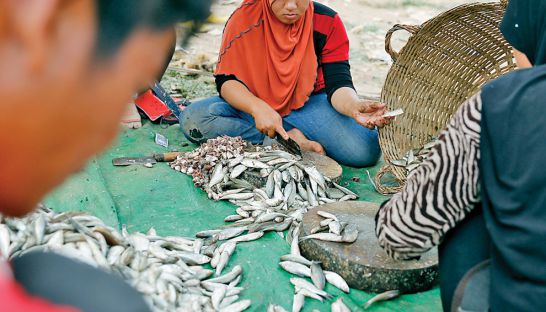Prahok fish yields up, but smaller to affect output
Prahok fish yields up, but smaller to affect output
With the onset of the fishing season for the Cambodian fermented fish condiment prahok, an Agriculture Ministry official said yesterday that fish yields this year have increased compared to 2014, but traders say most of the catch so far is too small to use for making the fish paste.

Eang Sophallet, spokesperson for the Agriculture Ministry, said the ministry does not have exact yield numbers yet, but that the increase in yields of trey riel, the fish used to make the condiment, was a result of a crackdown on illegal fishing in the Tonle Sap lake and Mekong River.
“We cracked down on illegal fishing, which is why we are getting bigger yields this season,” Sophallet said.
According to Sophallet, fishermen have been able to catch around six tonnes of fish an hour, which he said was highest he has seen in the last few years.
Hok Pring, a semi-processed prahok producer in Siem Reap province, said that despite an increase in yield this season, the fish are too small to make prahok and can only be used as feed for other fish and crocodiles.
She added that she has been able to buy only half the amount of fish this season, as compared to last year, with the price increasing marginally to 2,000 riel ($0.50) per kilogram of fish, which has been cut and scaled.
“I bought around 10 tonnes of prahok fish this year, whereas last year I could buy around 20 tonnes,” Pring said.
Chan Chhoen, a fish trader in Kampong Loung, a community of floating villages on the Tonle Sap, said that the low levels of water in the river have led to this year’s catch being too small in to use for prahok production.
“I used to collect around 60 tonnes of fish last year, but this year I have collected only 20 tonnes,” he said. “There are too many small fish that cannot be used to make Prahok.”
Chhoen added that for every 1 tonne of catch, only 200 kilograms of the fish could be used for prahok production.
The low level of water in the Tonle Sap have changed the natural conditions in which the fish grow, making them smaller than usual, according to Minh Bunly, a program coordinator at the Fishery Action Coalition Team.
“The low level of the Tonle Sap also means the fish cannot reach flooded forests, where they can grow to a bigger ,” he said, adding that the flooded forests around the lake provides a natural habitat and food supply for the fish.













